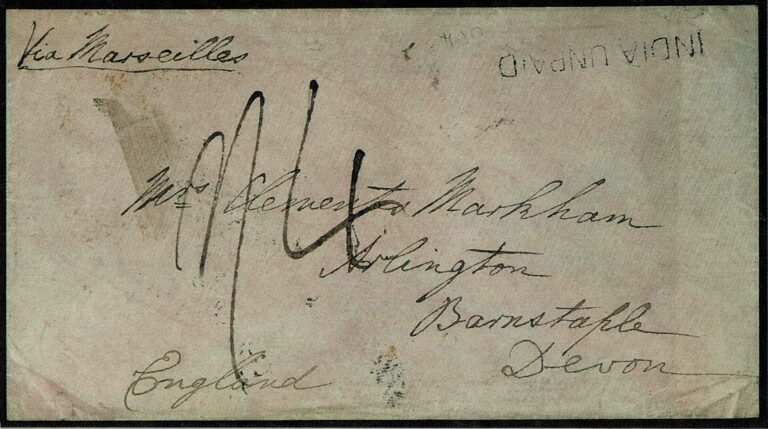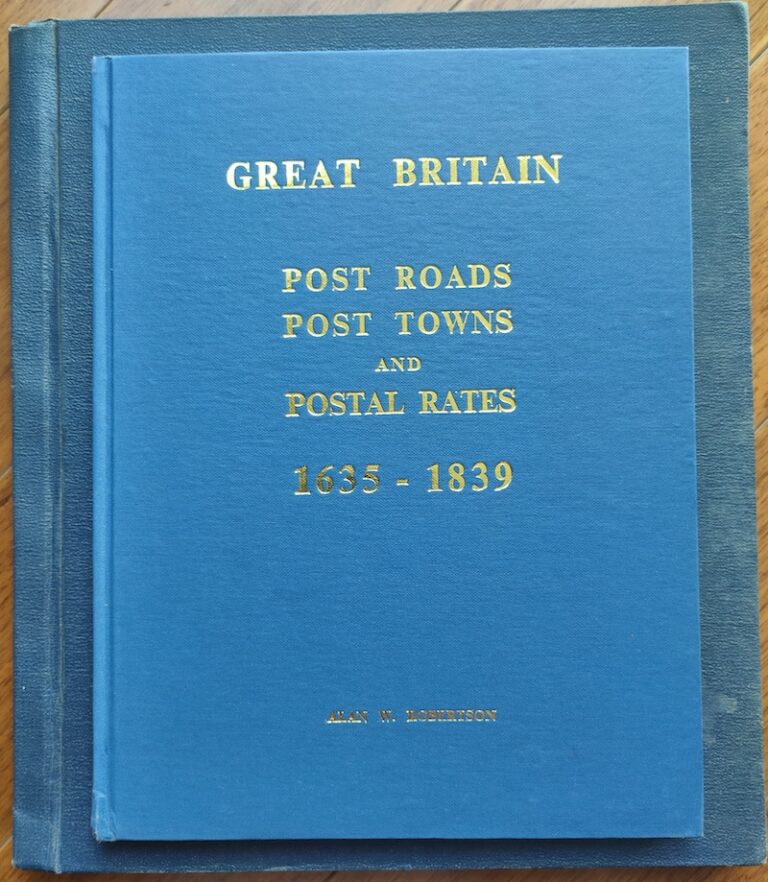Seasoned postal historians caution the inexperienced, who is unable to explain the route or the rate or markings on a particular cover, against jumping to the conclusion that ‘the post office made a mistake’. At the same time, one cannot rule out the possibility, however slim, of them indeed committing errors. Secondly, the postal historian has to often make peace with the fact that everything about a cover cannot be definitely explained and finality reached.
The cover in discussion will make the above points clear.
The Cover
The front and rear of an extremely interesting entire going from Calcutta to Edinburgh is illustrated as Figure 1 and 2. Datelined 21 May 1834, the letter was sent by the ship Ann (see the words “per ship Ann” which was then deleted and “first ship” mentioned and again “r Ann” mentioned at the bottom) to England.


Lloyd’s List No. 7008 dated 2 December 1834 shows Ann under Captain Tindall sailing from Calcutta on 20 June (it is likely that this is the date the ship was put to sea at the mouth of the Ganges) and arriving off Margate on 30 November. Since there is no mention of the ship calling at Plymouth, it is quite possible that her mail was landed there by another vessel or pilot boat. From Plymouth the letter went via London to Edinburgh reaching on 1 December 1834. [Thanks are due to Max Smith for his comments to my draft].
After Packet
The first interesting aspect of the letter is the manuscript ‘2/12’ on the rear. This fraction indicates that this is an ‘After Packet’ letter. An ‘After Packet’ consists of letters accepted from the public, on payment of an additional fee, after the expiry of the time limit for normal mails. While the ship on which the letters are to be sent may have left Calcutta, it would not have been put to sea given the distance of more than 80 miles (Figure 3). Such letters could be sent to Kedgeree, either by water or by land, so that it could still be put on board as the ship passed the mouth of the Hooghly river.

The ‘2’ denotes a weight of between one and two tolas (one tola being about 11.66 gm or 4/10ths of an ounce) and ‘12’ means 12 annas (12 pies = 1 anna and 16 annas = 1 Rupee) postage (which was prepaid). The latter can be bifurcated as ship postage of six annas and inland postage of six annas from Calcutta to Kedgeree; both these rates were set by the Bengal Presidency post office and were effective from 11 April 1832 to 30 September 1837.
Inland Rate
After landing at Plymouth and receiving the INDIA LETTER / PLYMOUTH (Robertson In. 1) handstamp, the letter was sent to London where it arrived 29 November. Plymouth, or more likely London, (see later discussion) marked the letter as due ‘2/2’ or 2 shillings 2 pence (2s2d or 26d) i.e., 1s10d (11d for a letter containing a single sheet of paper under one oz times two) applicable on a double letter for the 215 miles (170-230 miles bucket effective 09 July 1812 to 05 December 1838) from Plymouth to London and 4d India Letter for an item up to 3 oz.
‘2/2’ was deleted in London, or more likely Edinburgh, where the inland rate was recalculated to include the additional distance from London to Edinburgh; hence ‘2/10’ for 2s10d was marked.
London to Edinburgh was 396 miles making the Plymouth-Edinburgh via London mileage 611 miles. This would imply an inland rate of 2s8d (1s4d twice two) which when added to the ‘India Letter’ rate of 4d makes the total postage due 3s. However, London or rather Edinburgh marked ‘2/10’ for 2s10d. Why?
[The distances are given in Alan Robertson’s 1961 book Great Britain: Post Roads, Post Towns, and Postal Rates 1635 to 1839 and reproduced in Colin Tabeart’s Admiralty Mediterranean Steam Packets 1830 to 1857.]
The missing Additional Halfpenny
Another mystery is that the usual additional halfpenny (½d) handstamp cannot be found on this letter. From 09 June 1813 to 04 December 1839, all letters to/from Scotland (excepting a few exempted towns) from/to England or Ireland “carried in or by any Mail Coach or Carriage with more than Two Wheels” (Figure 4) were liable to be charged with an additional halfpenny. This toll or tax, alternatively referred to as Turnpike Tax or Scottish Wheel Tax, was payable per letter or packet. Why was the letter not charged this tax?

The Curricle between Edinburgh and Morpeth
To understand the issue of the missing additional halfpenny handstamp, I corresponded with Ian Baker and Michael Sanig who have co-authored the recent and definitive book on this subject. Readers are strongly recommended this book (Figure 4) if only to understand how a ‘side show’ of British postal history can have so much written about it, and be so fascinating!


The first point to consider is that the letter was likely carried on a curricle (Figure 6).
In 1830, with a view to hasten mails between London and Edinburgh, a curricle, a light two-wheeled carriage, was introduced between Newcastle (actually Morpeth which is 14 miles north) and Edinburgh. Mails carried by the curricle was expected to cover the 92½ miles in 9 hours 13 minutes compared to the 11 hours that the mail coach took to cover the 107 miles; this was on account of the route taken – the curricle going via Wooler and the mail coach taking the eastern coast route via Berwick. I was unable to find any postal map showing the curricle route and have hence adapted a contemporary one (Figure 7).

While mails carried by such two-wheeled carriages were outside the scope of the halfpenny tax, which applied only to carriages with more than two wheels, the Treasury (quite illegally) insisted that the tax nevertheless be charged, “towards defraying the expenses of the plan in question.” Hence this letter was liable to have been charged the additional halfpenny even it was carried by the curricle. That it was not is simply an act of omission on part of the postal authorities.
The ‘2/10’ rate and the Curricle
Now back to the ‘2/10’ rate. There were no marks applied on letters to show whether they went on the curricle or the mail coach. Hence, we cannot be sure whether this letter went via the curricle unless we consider that the ‘2/10’ applied on the letter was marked in Edinburgh.

Why do I say this?
Plymouth to Edinburgh via London taking the curricle route (Figure 8) was 596½ miles (215 + 396 – 107 + 92½). The London clerk, however, would not know which route the letter would take; the route over 600 miles or the one under. He would have surely marked ‘3’ as postage due. Only the Edinburgh clerk would be aware that it was carried by the curricle and hence would apply the correct rate of ‘2/10’ for 500-600 miles (1s3d single) rather than the one for 600-700 miles (1s4d single).
And if ‘2/10’ was marked at Edinburgh, it follows that ‘2/2’ was marked at London and not Plymouth.
Documentary Collaboration
[edit 3 February 2022] Appendix 31 of the Twenty-Second Report of the Commissioners of Inquiry into the Collection and Management of the Revenue Arising in Ireland and Great Britain. Post-Office Revenue, United Kingdom: Part V. Packet Establishments. Home stations (that’s a long title! unfortunately, the appendices are not available in the linked PDF file; I thank Don Heller for providing me with a copy) is ‘Letter from Secretary to the Post-office, transmitting Copies of the Instructions under which the Deputy Postmasters at the several Out ports in Great Britain act, in regard to the sending or receipt of Ship-letters; dated 7th January 1829.’
Paragraph 4 of Special Instruction dated July 1819 issued upon the passage of the Postage Act, 1819 (or the East India Letter Act) says:
4. Having taxed the letters for your own delivery with sea-postage, and debited yourself with the amount in the proper column of the account, you will carefully tax those for the cross roads, which must always be dispatched by the first post, and you will be the better able to do this business well, as all the ship letters for London are to be merely stamped, and sent untaxed in the canvas bags supplied for that purpose, which are to be put into the leathern London bags. The stamp for all these ship letters inwards is to be the common strait stamp. You will keep the receipts signed by the masters of ships for their gratuities till you transmit your monthly account; but you will enter the number of ship letters, each day received, in the form supplied for that purpose, and send the same to London with the letters in this bag.
This makes it clear that the initial markings were made in London and not at the port, unless the letter did not transit via London but by the cross roads.
Conclusion
Bringing all the analysis together, we conclude that is quite likely that in the case of this letter:
- The ship Ann did not call at Plymouth and mails were carried onshore by another vessel or a pilot boat
- Plymouth didn’t mark the initial rate of ‘2/2’; rather it was London
- The letter was carried by the Morpeth-Edinburgh curricle and not by the mail coach
- Edinburgh marked the final rate of ‘2/10’ knowing that the letter took the curricle and hence needed to be assessed for the inland rate bucket of 500-600 miles
- Edinburgh did not apply the additional halfpenny tax erroneously; there was no statute under which this toll could be waived
References
- Baker, Ian, David Graham, Michael Sanig, and Bill Shand. The Scottish Additional Halfpenny Mail Tax 1813-1839 & The Welsh Additional Halfpenny Mail Tax 1836-1839. Hamilton, Lanarkshire: The Scottish Postal History Society, 2017.
- Smith, Max, and Robert Johnson. Express Mail, After Packets, and Late Fees in India Before 1870. Wheathampstead, Herts, UK: Stuart Rossiter Trust, 2007.
- Tabeart, Colin. Admiralty Mediterranean Steam Packets 1830 to 1857. Limassol, Cyprus: James Bendon Ltd., 2002.






